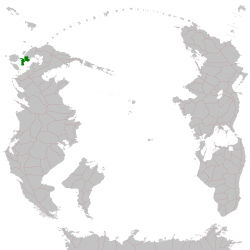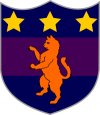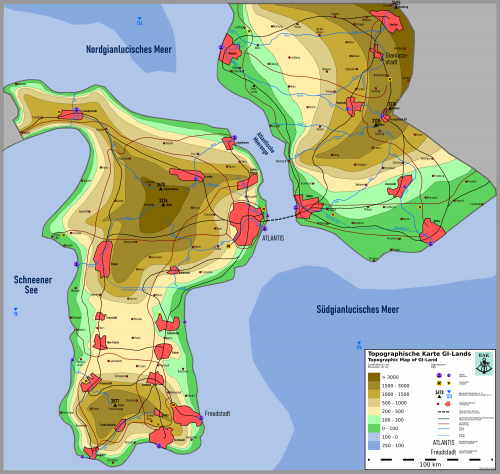GI-Land (Pacifica)
Federal Republic of GI-Land Bundesrepublik GI-Land | |
|---|---|
 Location of GI-Land in Pacifica | |
| Location | North-West Cordilia encompassed by the Serevan Sea, Astro Sea and the South Pacific Ocean |
| Capital and largest city | Atlantis |
| Official languages | Alman, Atlantic |
| Demonym(s) | Gianlucian |
| Government | Federal dictatorial democratic republic |
| Gianluca IV. | |
| [[Marja Sanddorn (Pacifica)|]] | |
| [[Sabine Meischel (Pacifica)|]] | |
| Byga Montebrok | |
| Legislature | Parliament |
| Rat | |
| Königspalast | |
| Formation | |
• Gianlucian Kingdom | 1 June 1305 |
• Republic of Gianlucaland | 1954 |
• Federal Republic of GI-Land | 2011 |
| Area | |
• Total | 62,693 km2 (24,206 sq mi) (128th) |
| Population | |
• 2020 census | 27,320,269 |
• Density | 435.78/km2 (1,128.7/sq mi) |
| GDP (nominal) | 2020 estimate |
• Total | TSP-$ 1.1 trillion |
| Currency | Gianlucian Tack (GAT) |
| Time zone | UTC-2 (CCT) |
| Date format | dd/mm/yyyy |
| Driving side | right |
| Calling code | +93 |
| World Forum Code | GI |
| Internet TLD | .gi |
GI-Land [d͜ʒiː ˈʌɪ lænd] (Alman: [ge ˈi lant], Atlantic: Rúkano [ˈɹʉːkaːno]), officially the Federal Republic of GI-Land (Alman: Bundesrepublik GI-Land [ˈbʊndəsʁepuˌbliːk ge ˈi lant]), is a federal state in north-west Cordilia bordered by Snolland in the west and T.S.S.S. in the east.
Having an area of 62 693 km² and a population of around 27 million people (2020), it's one of the most densely populated countries of Pacifica with on average 436 inhabitants per km².
GI-Land is a country consisting of the three partly-sovereign states of Atlantis, Greater GI-Land and Lesser GI-Land.
The city of Atlantis is the capital since the incorporation of Atlantis in 2011. It's at the same time the largest city with more than 2.8 million inhabitants. Other major cities include the former capital Gianlucastadt, the seat of the World Forum Committee for Science and Education, Freudstadt, Nordtor, Südtor and Tragas. All mentioned cities, except for Gianlucastadt, have more than one million inhabitants.
They are a founding member of the World Forum and held the position of Speaker of the Assembly thrice already.
The economy of the country is heavily based on services. GI-Land is known for having expertise in the fields of entertainment technology and media, vehicle manufacturing and traffic engineering.
Etymology
The name GI-Land is a shorter form of the formerly used Gianlucaland, which is used since the incorporation of Atlantis and the foundation of the new federal republic in 2011 in an attempt to unite the Atlantic and Gianlucian population better under a name that doesn't give off the notion, the Atlantics would be property of King Gianluca IV.
Gianlucaland itself is a compound out of Gianluca - the name of the tribe that has founded the Gianlucian Kingdom in 1305 - and "land".
The origin of the tribe's name is yet to be fully discovered. There are two theories prevalent however. The first theory is that the New Hazels and Catz united themselves mainly due to both being Christian people groups wanting to reflect this fact in their new official name. The other theory suggests that "Gian" and "Luca" could have been words or particles of words in an older Atlantic dialect that doesn't exist anymore. Both theories lack substantial evidence yet.
History
Pre-History (before xxxx BCE)
Rise of the Atlantics (xxxx BCE – 200 BCE)
Snovics, Hazles and Catz (200 BCE – 716 CE)
Hazle-Cat-War and the Great Calamity (716 – 732)
Expansion of the Gianlucas (732 – 1215)
Revolutionary Army and foundation of the Gianlucian Kingdom (1215 – 1305)
Establishment of the Gianlucian Kingdom as dominant power on Frastinia (1305 – 1xxx)
Gianlucian Empire (1xxx – 1935)
Frankism and Great War (1935 – 1954)
Republic of Gianlucaland and power struggles in Atlantis (1954 – 2011)
Incorporation of Atlantis and beyond (2011 – present)
Geography
Location and borders
Albeit stretching around 378 km from East to West and around 371 km from North to South, the total land area of GI-Land lays at only 62 693 km². This makes them the 52nd biggest (or 26th smallest) country in Cordilia.
The country consists of the three states Atlantis, Greater GI-Land and Lesser GI-Land. The first two are situated in the easternmost third of the Hazel Isle, that GI-Land shares with Snolland. Their border is placed at the narrowest part of the Atlantic panhandle, which is sandwiched between the Snovian Sea, a part of the Serevan Sea, and the North Gianlucian Sea, respectively part of the North Pacific Ocean. To the East the country borders T.S.S.S. mostly along the Gianlucian mountains of The Cordilles at first, before the border bends towards the South-East near Französisch Ort and goes in a straight line to the Serevan Sea.
The Hazel Isle and the "mainland" of GI-Land on the Frastinian Peninsula are divided by the 23 km wide Atlantic Strait. Anyhow both landmasses are nowadays connected through the Atlantic Strait Tunnel opened in 2014.
Geology, topography and hydrography
The current territory of GI-Land is shaped mainly by the Orrim and the Faburg plain on the Hazle Isle, and the North-West Cordille foreland and the Gianlucian plain in mainland GI-Land.
Mountains going up to over 3000 m in height can be found mainly in the North-East of GI-Land near the city of Nordtor. The only exception for this is Neptune's Mountain (Neptunsberg), which is located almost in the center of Atlantis near the city of Lindau. Being 3678 m high, it is the highest mountain of GI-Land and furthermore has the second highest summit in the Orrim.
| Name | Height |
|---|---|
| Neptunsberg | 3678 m |
| Nordberg | 3455 m |
| Nomo | 3236 m |
| Franzo | 3218 m |
| Nicker | 3179 m |
| Fritzl | 2877 m |
There are no major rivers of international importance flowing through GI-Land. Still a few smaller rivers are significant to the development of several cities and municipalities of GI-Land or even have a cultural importance as the Atlantic culture is built around the worship of "water deities".
Next to the natural rivers, there are six canals existing to simplify trade. Two of them, the Northern Canal (Nordkanal) and the Mid-Atlantic Canal (Mittatlantischer Kanal) are used by international transport ships regularly to decrease the time it would take to go around the Hazel Isle.
| Name | State | Length |
|---|---|---|
| Achim | Lesser GI-Land | 214.23 km |
| Anna | Atlantis | 67.15 km |
| Anne | Lesser GI-Land | 54.76 km |
| Ari | Greater GI-Land | 57.15 km |
| Ata | Atlantis | 117.51 km |
| Ced | Atlantis | 45.56 km |
| Juppi | Atlantis | 49.16 km |
| Katz | Lesser GI-Land | 130.26 km |
| Liese | Lesser GI-Land | 93.92 km |
| Lucia | Lesser GI-Land | 131.89 km |
| Luna | Lesser GI-Land | 101.92 km |
| Mø | Atlantis | 113.11 km |
| Torata | Atlantis | 96.72 km |
| Tripp | Lesser GI-Land | 66.35 km |
| Zog | Greater GI-Land | 72.34 km |
Climate and environment
Flora and fauna
Natural resources
Land use
Natural conservation areas
Natural hazards
Politics
Administrative divisions
Foreign relations
Military
Economy
GI-Land has a social market economy with a highly skilled labour force, a low level of corruption and an average level of innovation. Its monetary policy is set by the Gianlucian Central Bank, who also issues GI-Land’s national currency, the Gianlucian Tack (GAT). The bank tries to maintain the yearly inflation at around 2%.
Economic history
While the Gianlucian economy has been dependent on the exploitation and selling of its and its former colonies’ natural resources for most of the country’s history, the industrial revolution in the 1810s has been a turning point. The introduction of steam-powered machines through trade with the Austral Empire has not only led to higher production capacities and an increase in exports, but also to the first scientific boom, in which scientists and innovators have developed multiple concepts for complex machinery. With that they laid the foundation for innovations like modern cars or trains, which would eventually become goods GI-Land is one of the biggest exporters of up until today.
Due to decolonization and the subsequent loss of direct trading opportunities with several Pacifican countries in the late 1800s and early 1900s, the Gianlucian Empire’s economy was becoming more focused on the extended Frastinian region. That region however, had mostly protectionist policies in place, which ultimately meant a drastic loss of capital for the companies and decreasing disposable income and wealth for the populace. The following rise of Frankism and the participation in the Great War have helped dampen the economic decline of the empire, also partially due to the use of slave labor in the occupied territories.
After the surrender in 1954 and the partial deindustrialization in order to pay reparations to the victims of the Gianlucian invasions, the economy of the newly found republic has been in shambles. Economic policies, that combined a free market with a social welfare state, were the key to the quick rebuilding of the Gianlucian market and the reestablishment of foreign trade relations in the 1960s and ‘70s, that are known today as Wirtschaftswunderpolitik (economic wonder policy). It was during this time, the Gianlucian economy has started to be known for having expertise in vehicle manufacturing, traffic planning, cheap energy production through nuclear power and food service.
The second scientific boom occurred in the mid-1990s and arguably lasts up until now. While in the beginning, the Gianlucians mainly tried to compete with other nations in the field of telecommunications, entrepreneurs would soon switch to digital services and software development instead. This culminated in becoming a global leader in the digital entertainment industry of today. Further fields of scientific development include the renewable energy sector, which experienced a boom in recent years at the cost of nuclear energy and the domestic mining economy.
Current market situation
Whereas the primary sector is almost negligible nowadays in the Gianlucian economy, it only accounts for approximately 1% of the GDP, the secondary and tertiary sector are far more important, accounting for ca. 34% and 65% of the GDP respectively.
Since 1976 the Gianlucischer Wirtschaftsindex (Gianlucian Economic Index, GIWIX) in Osttor shows the 30, since 2011 50, largest Gianlucian companies by market capitalization. Currently (April 2022) roughly 40% of the companies listed in the index are part of the entertainment sector. Those include the streaming platforms Risa and Audit, but also several film producers and the gaming company Orion. Ca. 28% of the companies can be attributed to the manufacturing sector and include the Gianlucian branch of Aeronaut, the car manufacturer Volksmobil and the sports wear brand Fennick. The third largest sector is the food and food service sector with almost 11%, which contains companies like the fast food giant Schuhmachers or the chocolate producer Heinrich. All companies in the GIWIX together have a worth of around TSP-$ 846 billion.
International trade
GI-Land's geographic position is advantageous for international trade. Located at the Western boundary of Cordilia, some Gianlucian coastal cities have developed to be logistic hubs for maritime trade from the Western parts of Pacifica to the South Pacific region. The location around the Atlantic Strait, which is used by cargo ships travelling northbound from southern Cordilia, is profitable for GI-Land as they can charge cargo ships going through the strait or one of the alternative channels, that cut travel times at least in half unlike if a route alongside Bruuma and Puerto Pollo is taken.
GI-Land’s main economic partners are Besern, Erinor, Huawan and Sedunn. While there have been talks about free trade agreements with several countries, only one has been finalized up until today: an agreement with Snolland from 2008. With GI-Land co-founding the Concordia Entente in February 2022, the probability for a second, larger free trade agreement, also including the Frost Empire, Erinor and Sedunn, has increased. Talks on this have not begun yet.
Science and technology
The professional Gianlucian scientific community is one of the best funded in the South Pacific region, receiving support from both, the government, that spend ca. 4% of its budget on research and development, and private companies. GI-Land has profited from the scientific booms by becoming world-renowned innovators in the sectors of vehicle manufacturing and design, and software development. Green tech and medicinal research also became bigger in recent years, yet GI-Land is still not an innovation leader in those sectors. Former fields of heavy research in the Gianlucian scientific community include nuclear power production, telecommunications, computer hardware, resilient crops and fertilizers. In those areas, other countries have overtaken GI-Land in recent decades, which led to the government divesting of research funds in those sectors. The biggest scientific communities can be found at the universities in Nordtor, Atlantis and Freudstadt. The latter also hosts the WF-Committee for Science and Education.
GI-Land is part of the CPSC since 1998 and has an own space agency, but not an own launch site. Its biggest missions were its participation in modernising a module of the PSS in 2003 and the installment of a satellite for global traffic observations in 2009.
Tourism
Unlike its neighbors to the West, who profit from larger coastal areas and higher mountains, and to the East, who profit from steep climbable mountain ranges and offering a larger theme park industry, GI-Land is not as frequented by foreign tourists, albeit the number of travellers to GI-Land steadily increasing over the last few years.
GI-Land offers a variety of cultural facilities like museums or theatres, markets and spas. The dense transportation network does attract tourists from abroad too. Notable landmarks and sights include Neptune’s Mountain in the state of Atlantis, the Democracy Park in Gianlucastadt, the Königspalast building in Atlantis and the Gianniwood film studios in Südtor.
Future challenges
GI-Land is subject to demographic change. The birthrate has been declining for years already and even after the incorporation of Atlantis in 2011 there is no sign in sight, this development will be reversed anytime soon. This will eventually lead to higher government spending on pensions and healthcare, which would reduce the economic growth of the country in the future.
Furthermore, climate change is threatening the country. On the one hand rising sea levels and more frequent stark precipitation could lead to floods costing the society many losses in life and property due to how densely populated the country is. On the other hand the deceleration of currents bringing colder air into the region combined with the still continuing deforestation of some areas in GI-Land could lead to a desertification of the country. Chancellor Sanddorn and her green-liberal coalition have therefore agreed to make GI-Land climate neutral by 2040. There is also a rise of companies like Solstar or Zuhup noticeable, which focus on the construction of renewable energy plants or the development of CO2-capture methods.


